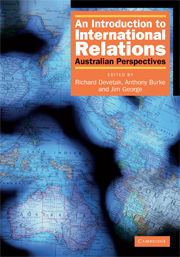Book contents
- Frontmatter
- Contents
- List of tables, figures and boxes
- List of contributors
- Preface and acknowledgments
- An introduction to international relations: the origins and changing agendas of a discipline
- 1 Theory and practice in Australian international relations: the search for identity and security
- Part 1 Theories of international relations
- Part 2 The traditional agenda: states, war and law
- 10 The modern state and its origins
- 11 Nationalism and war
- 12 Security
- 13 Arms control
- 14 The changing character of warfare
- 15 The ethics and laws of war
- 16 International law
- 17 International society and european expansion
- 18 Order and decolonisation in Southeast Asia
- 19 The cold war
- Part 3 The new agenda: globalisation and global governance
- Glossary of terms
- Bibliography
- Index
- References
18 - Order and decolonisation in Southeast Asia
from Part 2 - The traditional agenda: states, war and law
- Frontmatter
- Contents
- List of tables, figures and boxes
- List of contributors
- Preface and acknowledgments
- An introduction to international relations: the origins and changing agendas of a discipline
- 1 Theory and practice in Australian international relations: the search for identity and security
- Part 1 Theories of international relations
- Part 2 The traditional agenda: states, war and law
- 10 The modern state and its origins
- 11 Nationalism and war
- 12 Security
- 13 Arms control
- 14 The changing character of warfare
- 15 The ethics and laws of war
- 16 International law
- 17 International society and european expansion
- 18 Order and decolonisation in Southeast Asia
- 19 The cold war
- Part 3 The new agenda: globalisation and global governance
- Glossary of terms
- Bibliography
- Index
- References
Summary
Introduction
This chapter provides an introduction to the history, key processes, and structures of Southeast Asia's international relations since World War II. It does so not just because they have shaped the region, but because they have often been intricately linked to struggles over the shape of global order. It is also an area in which Australia has had a deep and sometimes troubled involvement: Australia has supported the independence of some states, tried to prevent that of others, and provided large amounts of aid, investment, diplomatic support and military assistance. It has joined wars and tried to end them, and has been a significant player in many of the major regional institutions and initiatives. Southeast Asia's recent history has been turbulent and extraordinary, taking in terrible wars and genocides, dictatorship and democratisation, rapid economic growth and social change, economic and political crisis, and novel and difficult experiments in regional diplomacy and intervention. It has challenged some of the dominant norms of international relations, and been subject to some of its most destructive forces.
In 1941, just prior to the Japanese attack on Pearl Harbor, Southeast Asia was an imperial playground. None of its peoples were free, and with the beginning of the Pacific War they were soon to exchange one colonial power for another, suffer the consequences of war and occupation, and emerge four years later into a radically transformed regional and international order that is still changing.
- Type
- Chapter
- Information
- An Introduction to International RelationsAustralian Perspectives, pp. 213 - 222Publisher: Cambridge University PressPrint publication year: 2007

